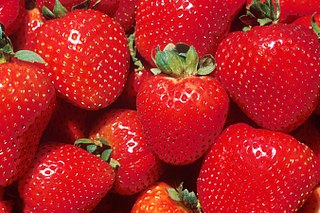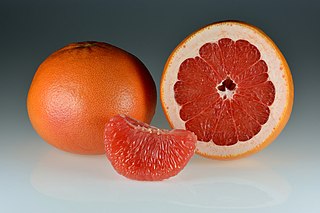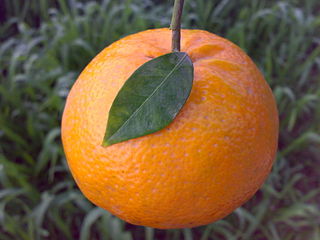
Red is the color at the long wavelength end of the visible spectrum of light, next to orange and opposite violet. It has a dominant wavelength of approximately 625–740 nanometres. It is a primary color in the RGB color model and a secondary color in the CMYK color model, and is the complementary color of cyan. Reds range from the brilliant yellow-tinged scarlet and vermillion to bluish-red crimson, and vary in shade from the pale red pink to the dark red burgundy.

Citrus is a genus of flowering trees and shrubs in the family Rutaceae. Plants in the genus produce citrus fruits, including important crops such as oranges, mandarins, lemons, grapefruits, pomelos, and limes.

Maclura pomifera, commonly known as the Osage orange, is a small deciduous tree or large shrub, native to the south-central United States. It typically grows about 8 to 15 metres (30–50 ft) tall. The distinctive fruit, a multiple fruit, is roughly spherical, bumpy, 8 to 15 centimetres (3–6 in) in diameter, and turns bright yellow-green in the fall. The fruits secrete a sticky white latex when cut or damaged. Despite the name "Osage orange", it is not related to the orange. It is a member of the mulberry family, Moraceae. Due to its latex secretions and woody pulp, the fruit is typically not eaten by humans and rarely by foraging animals. Ecologists Daniel H. Janzen and Paul S. Martin proposed in 1982 that the fruit of this species might be an example of what has come to be called an evolutionary anachronism—that is, a fruit coevolved with a large animal seed dispersal partner that is now extinct. This hypothesis is controversial.

The grapefruit is a subtropical citrus tree known for its relatively large, sour to semi-sweet, somewhat bitter fruit. The interior flesh is segmented and varies in color from pale yellow to dark pink/red.

Orange is the colour between yellow and red on the spectrum of visible light. The human eyes perceive orange when observing light with a dominant wavelength between roughly 585 and 620 nanometres. In traditional colour theory, it is a secondary colour of pigments, produced by mixing yellow and red. In the RGB colour model, it is a tertiary colour. It is named after the fruit of the same name.

A clementine is a tangor, a citrus fruit hybrid between a willowleaf mandarin orange and a sweet orange, named in honor of Clément Rodier, a French missionary who first discovered and propagated the cultivar in Algeria. The exterior is a deep orange colour with a smooth, glossy appearance. Clementines can be separated into 7 to 14 segments. Similar to tangerines, they tend to be easy to peel. They are typically juicy and sweet, with less acid than oranges. Their oils, like other citrus fruits, contain mostly limonene as well as myrcene, linalool, α-pinene and many complex aromatics.

The navel orange is a variety of orange with a characteristic second fruit at the apex, which protrudes slightly like a human navel. This variety first was caused by a mutation in an orange tree, and first appeared in the early 19th century at a monastery in Bahia, Brazil. The mutation caused the orange to develop a second fruit at its base, opposite the stem, embedded within the peel of the primary orange. This mutation also caused it to be seedless, meaning the only way the plant can be propogated is by cutting and grafting.

Bixa orellana, also known as achiote, is a shrub or small tree native to Central America. Bixa orellana is grown in many countries worldwide.

The blood orange is a variety of orange with crimson, near blood-colored flesh. It is one of the sweet orange varieties. It is also known as the raspberry orange.

The oroblanco, oro blanco, or sweetie is a citrus hybrid, resulting from a cross between an acidless pomelo and a Marsh grapefruit. Its fruit is oblate and mostly seedless, with a thick rind that remains green long after it has already matured. It has a sweet, mild taste, and lacks the bitterness generally associated with grapefruit. It requires less heat for growth than other varieties of grapefruit and are harvestable sooner. Oroblancos grown in moderate climates tend to yield the highest-quality fruit.

The Valencia orange is a sweet orange cultivar named after the famed oranges in València, Spain. It was first hybridized by pioneer American agronomist and land developer William Wolfskill in the mid-19th century on his farm in Santa Ana, southern California, United States, North America.

The orange, also called sweet orange to distinguish it from the bitter orange, is the fruit of a tree in the family Rutaceae. Botanically, this is the hybrid Citrus × sinensis, between the pomelo and the mandarin orange. The chloroplast genome, and therefore the maternal line, is that of pomelo. The sweet orange has had its full genome sequenced.

The Kinnow is a high yield mandarin hybrid cultivated extensively in the wider Punjab region of India and Pakistan.

Cam sành or King orange is a citrus hybrid originating in Vietnam.

The Cara cara navel orange, or red-fleshed navel orange, is an early-to-midseason navel orange noted for its pinkish-to-reddish-orange flesh.

Eliza Tibbets was among early American settlers and founders of Riverside, California; she was an activist in Washington, D.C., for progressive social causes, including freedmen's rights and universal suffrage before going to the West Coast. A spiritualist, she led seances in Riverside. She became known for successfully growing the first two hybrid Washington navel orange trees in California.

The lemon is a species of small evergreen tree in the flowering plant family Rutaceae, native to Asia, primarily Northeast India (Assam), Northern Myanmar, and China.
Riverside, California, was founded in 1870, and named for its location beside the Santa Ana River. It became the county seat when Riverside County, California, was established in 1893.

The 'Valencia Pride' mango is a named late-season mango cultivar that originated in south Florida.

The Midknight Valencia orange is a South African variety of the Valencia orange. Its exact origin is unknown, however, around 1927, this variety was first noticed, growing among Valencia orange trees in an orchard at Addo, Eastern Cape, South Africa by A.P. Knight whom the orange was later named after. In following years, more observations were made documenting characteristics of the orange and coming to the conclusion that it should be considered a variety of the Valencia orange.


















